Flower Photography
Flowers cry out to be photographed. They burst with color, and even the smallest of them is beautiful. The question is, how does a photographer make the shot interesting? Part of the beauty in a flower is the scent carried on a slight breeze, the heat of the sun on the skin, the joy of being outside. The combined experience will rarely translate into the frame of your photograph.
Spanish Rose is one of my early photographs.
It shows the beauty of a rose, but other than including the diagonal line of the walkway to create a composition in the frame and the slightly luminescent glow of the rose, the photograph doesn’t go beyond that. I enjoy the colors of the rose, and have used this piece as background art.
How do we bring more to our floral photographs, incorporating the energy and feeling of a walk in open air gardens on a beautiful spring or summer day?
Get close
In Heart of the Flower, I came close to the flower, so that it spilled beyond the frame, making the image more dynamic. The veins of the petals reach out like a sunburst. While the stamen, drenched with pollen, forms a central focal point, I find myself following the lines out to the edges, always returning to the center again.
Look up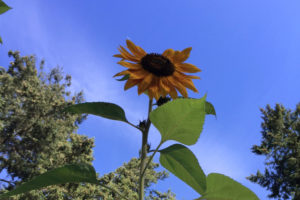
This Sunflower was in the garden of a friend of the family, high above our heads. While it is certainly easier to look up at a sunflower growing ten feet into the air than it is get an upward perspective on flowers that grow lower to the ground, the change of perspective is certainly worth it. It did take a bit of work to get to a spot where the sky was the predominant backdrop, even for this shot, all without trampling the garden.
Explore the context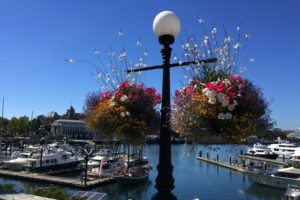
Flowers by the sea: The hanging flowers in Victoria, Canada pop with color; converting what might have been an average seascape into something vibrant. With the spray of white flowers reach upward, like so many birds hovering above the flowers, and the black pole leading up to the light fixture provides an anchor, we have both the illusion of movement and stillness.
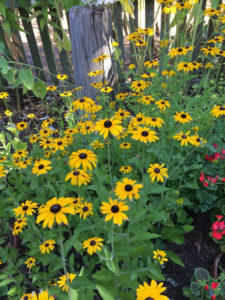 Back Yard Susans: I enjoy the diagonal flow of the flowers. What really adds shape to this image is the rustic fence in the background, giving a context that evokes sitting out on a summer’s day in a comfortable garden in the country. I can almost hear buzzing in the air, and feel a soft wind. Lemonade, anyone?
Back Yard Susans: I enjoy the diagonal flow of the flowers. What really adds shape to this image is the rustic fence in the background, giving a context that evokes sitting out on a summer’s day in a comfortable garden in the country. I can almost hear buzzing in the air, and feel a soft wind. Lemonade, anyone?
Focus on texture
Purple Hydrangea: The variations of tone in this hydrangea, along with the contrast of the dark green leaves and the play of light and shadow, provide an abundance of color. Beyond that, the diverse shapes and textures add interest to this photograph.
Lavender Fields
These two photog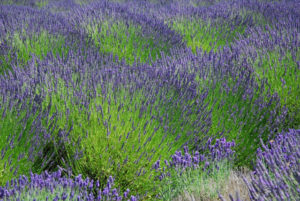 raphs have several aspects that are worth noting. The first one focuses on the texture of the lavender, the rounded clumps forming a large texture, and the individual blossoms on their individual stalks forming a more detailed layer of texture. This is something a painter might paint.
raphs have several aspects that are worth noting. The first one focuses on the texture of the lavender, the rounded clumps forming a large texture, and the individual blossoms on their individual stalks forming a more detailed layer of texture. This is something a painter might paint.
The second images shows what a horizon can add. Beyond the lavender is not sky but rather a field of grass, but the line serves the same purpose, creating a context for the image.
Let the critters photo-bomb
This photograph is also an example of how cropping can make a difference.
The original fame of Nectar is only interesting because of the critter and the bright colors. 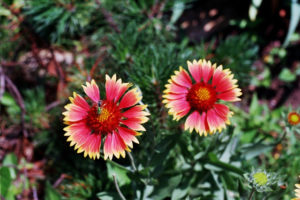
Cropped, it becomes dynamic. Ideally, I would have come in closer, but sometimes there is a time limitation, such as catching the image while the bee is still there. While it may not always be possible to frame the shot just right in the moment, cropping allows you to hone in on what is important. Of course, there is a price for cropping: it limits the size of the final printed photograph, so there is value in getting as close to the final frame as possible.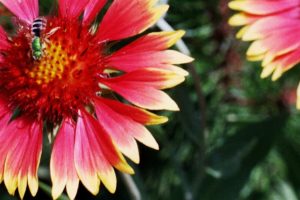
Light, shadow, angle, texture, content, and frame all play a part in bringing out the most of flower photographs. To get the image desired, play with them all, photographing the same flowers multiple times, varying distance and angle, composing the shot in different ways. Start with the beauty that is there, and use every technique available to bring it out, and perhaps even enhance it, in a photograph’s two dimensions.
Photographing flowers is a joy, not only because of the photograph at the end of the process, but the experience at the start of it. Spring and Summer call for us to come outside and experience the color, heat, movement and light of the warmer seasons. The photographer’s challenge is to represent a bit of that in the image caught by the camera.

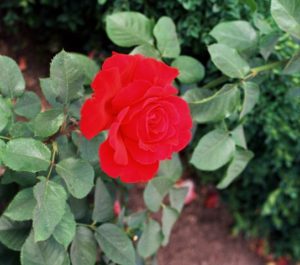
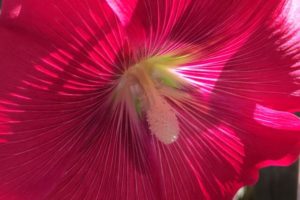
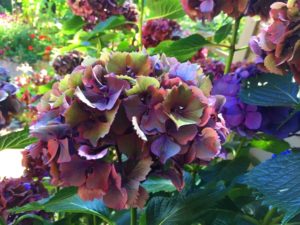
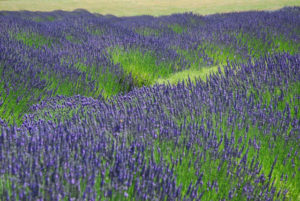
Comments
Flower Photography — No Comments